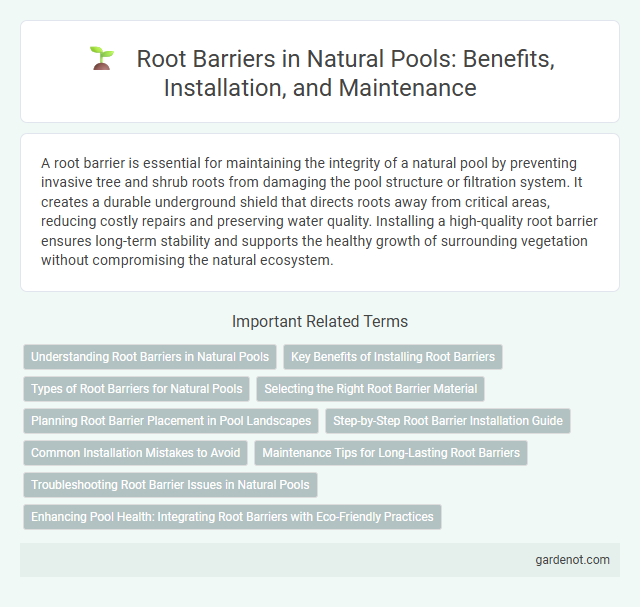A root barrier is essential for maintaining the integrity of a natural pool by preventing invasive tree and shrub roots from damaging the pool structure or filtration system. It creates a durable underground shield that directs roots away from critical areas, reducing costly repairs and preserving water quality. Installing a high-quality root barrier ensures long-term stability and supports the healthy growth of surrounding vegetation without compromising the natural ecosystem.
Understanding Root Barriers in Natural Pools
Root barriers in natural pools are essential for preventing invasive plant roots from penetrating and compromising the liner or structure. These barriers are typically made from durable, flexible materials like high-density polyethylene (HDPE), which block root growth while allowing water filtration. Proper installation of root barriers ensures the longevity of the natural pool by protecting the waterproof shell from damage caused by aggressive root systems.
Key Benefits of Installing Root Barriers
Installing root barriers in natural pools prevents invasive plant roots from damaging pool liners or filtration systems, ensuring long-term structural integrity. These barriers promote healthy plant growth by directing roots away from sensitive areas, reducing maintenance needs. Root barriers also enhance water quality by minimizing debris and root intrusion, contributing to a cleaner, safer swimming environment.
Types of Root Barriers for Natural Pools
Root barriers for natural pools include plastic root barriers, metal sheet barriers, and biodegradable root barriers, each designed to prevent invasive tree and plant roots from penetrating pool structures. Plastic root barriers, typically made of high-density polyethylene (HDPE), provide flexible and durable protection against root intrusion while being resistant to moisture and chemicals. Metal sheet barriers, often made from galvanized steel or aluminum, offer rigid and long-lasting obstruction but require careful installation to avoid corrosion, whereas biodegradable barriers use natural materials that decompose over time, suitable for less permanent protection scenarios.
Selecting the Right Root Barrier Material
Selecting the right root barrier material is essential for protecting natural pools from invasive root damage. High-density polyethylene (HDPE) and polypropylene are popular choices due to their durability, flexibility, and resistance to chemicals and UV rays. Choosing a root barrier with a minimum thickness of 20 mils ensures long-lasting protection while allowing easy installation around pool liners and landscaping features.
Planning Root Barrier Placement in Pool Landscapes
Planning root barrier placement in pool landscapes requires careful assessment of tree species, root growth patterns, and proximity to pool structures to prevent damage and maintain water quality. Selecting durable, flexible materials designed for underground installation ensures effective root deflection without harming surrounding vegetation or pool integrity. Properly positioned root barriers reduce costly repairs by protecting plumbing, pool walls, and surrounding hardscapes from invasive root intrusion.
Step-by-Step Root Barrier Installation Guide
Installing a root barrier in a natural pool begins with selecting a durable, waterproof material such as high-density polyethylene (HDPE) to prevent unwanted root intrusion. Excavate a trench around the pool perimeter to a depth reaching the root zone, then carefully place and secure the barrier vertically to block roots from penetrating the pool liner. Backfill the trench with soil and compact it to ensure the root barrier remains firmly in place, effectively protecting the natural pool ecosystem.
Common Installation Mistakes to Avoid
Installing a root barrier in a natural pool requires careful placement to prevent water seepage and root intrusion, which can damage the pool structure. Common mistakes include positioning the barrier too shallow or too deep, leading to ineffective root control or soil destabilization. Ensuring the barrier is installed vertically and continuously around the pool perimeter optimizes root management and prolongs the pool's durability.
Maintenance Tips for Long-Lasting Root Barriers
Effective maintenance of root barriers in natural pools involves regular inspection and removal of debris to prevent clogging and root infiltration. Applying a protective coating can enhance durability, ensuring the barrier remains resistant to water and root damage over time. Proper soil compaction around the barrier further minimizes displacement and prolongs its functional lifespan.
Troubleshooting Root Barrier Issues in Natural Pools
Root barrier issues in natural pools often cause water leakage and plant root intrusion, compromising the pool's structural integrity. Identifying damaged or improperly installed root barriers prevents invasive roots from penetrating liners and filtration systems. Regular inspections and prompt repairs ensure optimal pool function and longevity by maintaining effective root containment.
Enhancing Pool Health: Integrating Root Barriers with Eco-Friendly Practices
Root barriers play a crucial role in enhancing natural pool health by preventing invasive tree roots from penetrating pool structures and disrupting water balance. Integrating root barriers with eco-friendly practices such as using biodegradable materials and sustainable landscaping ensures long-term pool integrity and promotes a balanced ecosystem. This synergy supports natural filtration processes, maintaining clear water and reducing maintenance needs.
Root barrier Infographic

 gardenot.com
gardenot.com